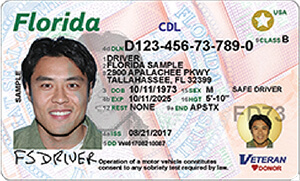- Updated for March 2025
- Based on 2025 FL commercial driver's license manual
Free Florida CDL Combination Practice Test 2025
The great state of Florida can offer major economic opportunities to tractor-trailer drivers because of its strong aerospace, agricultural, logistics, and trade sectors.
A significant aerospace industry has developed from the presence of NASA and the military in the state. This high-tech sector needs trucks to deliver equipment and supplies to it and to transport its products.
Florida is, of course, a major agricultural state, producing tomatoes, oranges, bell peppers, strawberries, and other produce. Seasonal opportunities exist for truckers to transport this produce to distribution chains or directly to grocery store chains.
Miami International Airport carries more cargo by volume than any other U.S. airport. PortMiami is one of the largest cargo ports in the country. Tractor-trailer drivers are in demand to transport shipping containers from Florida’s seaports to warehouses or distribution centers and to transport cargo from Miami International Airport to various inland destinations.
One of the most important trucking routes on the East Coast is Interstate 95, which runs northward to Washington, D.C., New York City, and Boston and then to the Canadian border in Maine. Other important trucking routes include Interstates 4, 10, and 75; U.S. Routes 27 and 441; and State Route 91.
To be allowed to drive semi-trucks or tractor-trailers in Florida, you should obtain a Class A Commercial Driver’s License (CDL). This type of CDL will allow you to operate combination vehicles with a Gross Combination Weight Rating (GCWR) of 26,001 pounds or more, in which the towed vehicle weighs more than 10,000 pounds.
All aspiring commercial drivers, regardless of the class of CDL they’re applying for, must first obtain a Commercial Learner’s Permit (CLP) to practice commercial driving. For that, they must submit to a medical examination and pass the official General Knowledge test on general commercial driving theory.
Aspiring Class A semi-truck drivers like you must also pass the official Combination Vehicles knowledge test. The official Florida Commercial Driver License Manual (Florida CDL Handbook 2025) contains all the information covered by the official knowledge test. However, you may find this study guide hard to learn from. One better study tool is our set of Combination practice tests like this one. The structure and content of this free Florida CDL Combination practice test are similar to those of the official test. It’s also up to date as of March, 2025. On this practice test, you’ll find 30 questions and answers on such topics as basic driving techniques, combination air brake systems, coupling and uncoupling, and pre-trip inspections. But unlike the official test, each of our practice questions includes a helpful hint and an explanation of the correct answer.
- Perfect for first-time and renewal CDL/CLP applicants, and those adding endorsements
- Triple-checked for accuracy
What you need to know

What to expect on the actual FL DMV exam
questions
correct answers to pass
passing score
List of questions (classic view)
- To prevent a rollover while you're driving a combination vehicle, you should
- What is the best way to test the trailer service brakes?
- What does the trailer air supply control do?
- During a walk-around inspection of a combination vehicle, you should check to make sure that
- Which of the following is NOT part of inspecting the coupling?
- After coupling, how much space should there be between the lower and upper fifth wheel?
- Which of the following is NOT part of testing the tractor protection valve?
- If you use the trailer hand valve while driving,
- Which of the following is NOT a way to tell if your trailer is equipped with an antilock braking system (ABS)?
- Which of the following control air in the service line?
- When parking a vehicle that does not have spring brakes, you should use chocks
- Which of the following is NOT part of checking that air is flowing to all trailers?
- What is the first step in coupling a tractor-semitrailer?
- To drive, how high do you need to raise the landing gear?
- If you try to couple when the trailer is too high,
- Which of the following statements about an antilock braking system (ABS) is FALSE?
- To back a trailer, what should you do?
- Which of the following types of vehicles are more likely to get stuck at a raised railroad crossing?
- What is the definition of "off-tracking?"
- Where would you find the shut-off valves?
- Which of the following is NOT a purpose of the emergency air line?
- While uncoupling, what should you do AFTER you unlock the fifth wheel?
- Which of the following is most likely to roll over?
- To straighten out a jackknifing trailer, should you apply the trailer hand brake?
- When you check the lower fifth wheel during the coupling process, you do NOT need to make sure
- Loss of air pressure in the emergency line causes
- Which of these statements is true?
- If you cannot make a right turn without swinging into another lane, what should you do?
- If there is a major leak in the _________, the tractor protection valve will close and the trailer emergency brakes will come on.
- The rear wheels of which vehicle will off-track the most?
- Alabama: Test 1 / Test 2
- Alaska: Test 1 / Test 2
- Arizona: Test 1 / Test 2
- Arkansas: Test 1 / Test 2
- California: Test 1 / Test 2
- Colorado: Test 1 / Test 2
- Connecticut: Test 1 / Test 2
- Delaware: Test 1 / Test 2
- District of Columbia: Test 1 / Test 2
- Florida: Test 1 / Test 2
- Georgia: Test 1 / Test 2
- Hawaii: Test 1 / Test 2
- Idaho: Test 1 / Test 2
- Illinois: Test 1 / Test 2
- Indiana: Test 1 / Test 2
- Iowa: Test 1 / Test 2
- Kansas: Test 1 / Test 2
- Kentucky: Test 1 / Test 2
- Louisiana: Test 1 / Test 2
- Maine: Test 1 / Test 2
- Maryland: Test 1 / Test 2
- Massachusetts: Test 1 / Test 2
- Michigan: Test 1 / Test 2
- Minnesota: Test 1 / Test 2
- Mississippi: Test 1 / Test 2
- Missouri: Test 1 / Test 2
- Montana: Test 1 / Test 2
- Nebraska: Test 1 / Test 2
- Nevada: Test 1 / Test 2
- New Hampshire: Test 1 / Test 2
- New Jersey: Test 1 / Test 2
- New Mexico: Test 1 / Test 2
- New York: Test 1 / Test 2
- North Carolina: Test 1 / Test 2
- North Dakota: Test 1 / Test 2
- Ohio: Test 1 / Test 2
- Oklahoma: Test 1 / Test 2
- Oregon: Test 1 / Test 2
- Pennsylvania: Test 1 / Test 2
- Rhode Island: Test 1 / Test 2
- South Carolina: Test 1 / Test 2
- South Dakota: Test 1 / Test 2
- Tennessee: Test 1 / Test 2
- Texas: Test 1 / Test 2
- Utah: Test 1 / Test 2
- Vermont: Test 1 / Test 2
- Virginia: Test 1 / Test 2
- Washington: Test 1 / Test 2
- West Virginia: Test 1 / Test 2
- Wisconsin: Test 1 / Test 2
- Wyoming: Test 1 / Test 2
Your go-to, trusted source
Experience the Driving-Tests differenceOur commitment to accuracy and quality in our practice tests
Explore our rigorous, multi-tiered verification process that ensures each question mirrors the official manual for unparalleled accuracy.

At Driving-Tests.org, we understand the importance of reliable and accurate practice tests to help you prepare for your DMV exam. That's why we've developed a meticulous process to create and continually update our practice questions, ensuring they reflect the most current driving laws and regulations.
Here's an inside look at how we maintain the highest quality in our practice tests.
Content Creation and Verification Process
- Alignment with Official Manuals:
Every question we develop is based on the most recent version of each state's official driving manual. Our team regularly monitors each state DMV's website for the latest updates to ensure our practice tests are always aligned with the most current information. - Community Feedback Integration:
We leverage feedback from our vast community of users to understand which topics are most frequently tested. This helps us focus on the areas that are most relevant and beneficial for your preparation. - Expert Content Creation:
Our in-house editor, Steven, who has extensive experience in driver education, crafts each question with precision. He conducts a thorough review of each question against the official manuals to ensure accuracy. - Rigorous Review Process:
Once Steven has finalized a set of questions, our team conducts a joint review session. This second level of scrutiny involves content accuracy, proofreading, and fact-checking to eliminate any errors. - User Feedback Mechanism:
After a question goes live on our site, we keep the lines of communication open. Each question features a feedback button, inviting users to report any issues or errors. This continuous feedback loop allows us to address and rectify any concerns promptly. - Responsive Updates:
In line with our commitment to accuracy, we quickly update our practice questions to reflect any changes in the DMV manuals. Additionally, we update the free electronic copy of the state's driver's license manuals on our site, typically within a few days after the DMV publishes them.
Our thorough quality control process ensures that you have access to practice tests that are as accurate and up-to-date as possible. We believe in the power of well-prepared drivers and are dedicated to providing you with the best study tools to help you succeed on your DMV exam.
Pass the First Time – Guaranteed
You’re moments away from your results.
Before you view them, see how 1.15 million drivers used Premium to pass faster.
Real Exam-Like Florida Questions
Get all exam-like questions seen on the real test.
99.06% Pass Rate vs. 49% Average
Most Premium users pass on their first try.
Money-Back Guarantee
We stand behind you until you pass.




